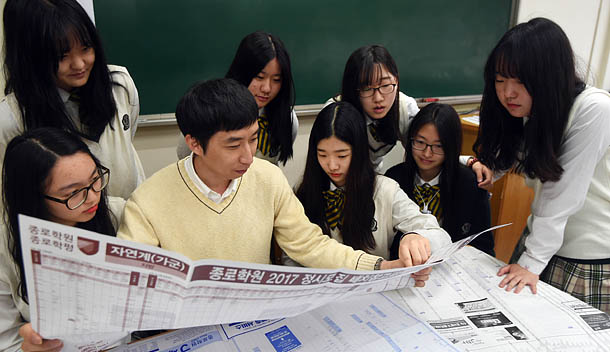CSAT has now become even more difficult

Senior students of Yeongbok Girls’ High School in Suwon, Gyeonggi, with their teacher, peruse the breakdown of CSAT scores and universities suggested by private cram schools on Wednesday, when seniors received their individual CSAT scores. [NEWSIS]
On Wednesday, the Korea Institute of Curriculum and Evaluation, a government organization that oversees the administration of the test, announced the breakdown of scores for the exam.
According to the results, 1,277 students or 0.23 percent received full points on the Korean language section, compared to 0.8 percent for section A and 0.3 percent for section B last year.
Subjects for the CSAT in 2014 and 2015 were separated by difficulty into sections A and B, but this division was removed for this year’s exam, as the concentration of high-achievers in the B section caused a controversy over the exam’s fairness.
The percentage of perfect scores was 0.07, or 133 students, for Mathematics I and 0.15 percent, or 534 students, for Mathematics II, compared to 1.66 percent for Math A and 0.48 percent for Math B last year. The percentage of perfect scores in the English section increased slightly from 0.48 percent last year to 0.72 this year.
This is the first time the percentage of perfect scores was below 1 percent for all three sections after the Ministry of Education announced its policy of maintaining a 1 percent perfect score rate in 2011.
“It seems like the government is trying to adjust the difficulty and keep the assessment function of the CSAT without depending on its 1 percent policy,” said Ahn Yeon-keun, a teacher at Jamsil High School. “The CSAT questions are still made in accordance with school curricula and EBS [Educational Broadcasting System] textbooks, so students should be able to prepare for the exam without excessive private education.”
Three students, Kim Jae-kyung of Hankuk Academy of Foreign Studies in Gyeonggi, Lee Young-rae of Haksung High School in Ulsan and Kim Ye-lim out of Banpo High School in Seoul got every question correct on the exam this year.
The CSAT is based on a relative grading system in which students are divided into nine groups for each subject based on their scores, with one being the highest.
The social studies and science sections turned out to be more challenging than the year before, as it was more heavily weighted.
Korean history, which became a compulsory CSAT subject this year, was graded on an absolute scale and 21 percent of test-takers were divided to the first-tier.
In Korea, high school students are divided into two tracks - general sciences and liberal arts. General science majors are required to complete the science section on the CSAT, while liberal arts students must take the social studies section.
The percentage of students who chose the social studies section dropped from 57.5 percent last year to 53.7 percent this year, while those who opted for the science section grew from 41.1 percent last year to 45.1 percent this year.
College admissions for general science majors therefore are likely to become tougher this year, according to educational experts.
Lee Chi-woo, a consultant with the college admissions company Visang, said, “For general science majors, test scores in math and science will determine their college admissions, while Korean language and math will be important for liberal arts majors.”
Now the rush for college admissions begins for students entering college in the spring semester of 2017, with results for regular applications to be announced by universities by early February.
Educational experts recommended students to pay attention to the number of students universities will accept, as the recent structural reform of universities might have led to changes. “Some departments at universities were removed or integrated to others this year. Applicants should take a close look at the selection processes of departments they’re applying for.”
BY NAM YOON-SEO, KIM YU-NA [kim.yuna1@joongang.co.kr]










with the Korea JoongAng Daily
To write comments, please log in to one of the accounts.
Standards Board Policy (0/250자)